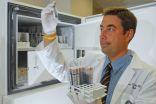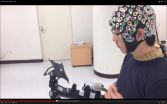(Press-News.org) BOSTON, Aug. 18, 2015 -- Cranberries are often touted as a way to protect against urinary tract infections, but that may be just the beginning. Researchers fed cranberry extracts to mice with colon cancer and found that the tumors diminished in size and number. Identifying the therapeutic molecules in the tart fruit could lead to a better understanding of its anti-cancer potential, they say.
The team will describe their approach in one of more than 9,000 presentations at the 250th National Meeting & Exposition of the American Chemical Society (ACS), the world's largest scientific society, taking place here through Thursday.
According to the American Cancer Society, one in 20 Americans will develop colon cancer at some point in his or her lifetime. While progress has been made on the detection and treatment of colon cancer, it remains the second leading cause of cancer-related deaths in the U.S.
Colon cancer may offer a particularly good target for a dietary treatment, says Catherine Neto, Ph.D., simply due to the anatomy of digestion. "Cranberry extracts may also afford protection toward other cancers, but it seems reasonable to look at colon cancer," she says. "Cranberry constituents and metabolites should be bioavailable to the colon as digestion proceeds."
In previous studies, Neto and colleagues at the University of Massachusetts, Dartmouth, found that chemicals derived from cranberry extracts could selectively kill off colon tumor cells in laboratory dishes. "We've identified several compounds in cranberry extracts over the years that seemed promising, but we've always wanted to look at what happens with the compounds in an animal model of cancer," Neto says. This led to a collaboration with Hang Xiao, Ph.D., of the University of Massachusetts, Amherst. His team had developed a mouse model that mimics the type of colon cancer associated with colitis, an inflammatory bowel condition that affects hundreds of thousands of people in the U.S.
For Neto's part, her team generated three powdered cranberry extracts: a whole fruit powder, an extract containing only the cranberry polyphenols, and one containing only the non-polyphenol components of the fruit. Some evidence suggests that polyphenols have anti-inflammatory properties, and she wanted to assess their contribution to the cranberry's overall impact.
The researchers mixed the cranberry extracts into the meals of mice with colon cancer. She notes that the mice do not seem to mind the tart flavor. After 20 weeks, the mice given the whole cranberry extract had about half the number of tumors as mice that received no cranberry in their chow. The remaining tumors in the cranberry-fed mice were also smaller. Plus, the cranberry extracts seemed to reduce the levels of inflammation markers in the mice.
"Basically, what we found was pretty encouraging. All preparations were effective to some degree, but the whole cranberry extract was the most effective," says Neto. "There may be some synergy between polyphenol and non-polyphenol constituents." Neto's graduate student Sarah Frade will present the work at the ACS meeting.
In the study, the researchers were careful not to give the mice an absurd amount of cranberry. "This is approximately equivalent to a cup a day of cranberries if you were a human instead of a mouse," Neto says. However, she's not sure someone could get the same benefits from juice, which lacks some of the components in the skin of the cranberry.
Currently, Neto is looking deeper into the cranberry to see if she can isolate individual components responsible for its anti-cancer properties. The researchers are also analyzing the metabolites in the mice that consumed the fruit extracts to better understand what happens due to mouse metabolism after the cranberry components are digested.
INFORMATION:
Neto acknowledges funding from the UMass President's Science and Technology Initiative.
The American Chemical Society is a nonprofit organization chartered by the U.S. Congress. With more than 158,000 members, ACS is the world's largest scientific society and a global leader in providing access to chemistry-related research through its multiple databases, peer-reviewed journals and scientific conferences. Its main offices are in Washington, D.C., and Columbus, Ohio.
To automatically receive news releases from the American Chemical Society, contact newsroom@acs.org.
Note to journalists: Please report that this research was presented at a meeting of the American Chemical Society.
Follow us: Twitter | Facebook
Title
Inhibition of colon cancer growth and inflammation in cellular and mouse models by cranberry extracts (Vaccinium macrocarpon)
Abstract
The ability of cranberry fruit extracts to inhibit colon carcinogenesis is under investigation using a combination of in vitro and in vivo approaches. Extracts and compounds from cranberry fruit (Vaccinium macrocarpon) were observed to decrease the proliferation of HCT116 and HT-29 colon tumor cells, while growth of CCD-18 normal colon cells was impacted to a lesser extent. A cranberry feeding study was conducted using AOM/DSS mice, a model of colitis-associated colon carcinogenesis. Mice were treated with azoxymethane and dextran sodium sulfate to induce inflammation-driven colon carcinogenesis, while receiving AIN-93 diet containing whole cranberry powder (WCP), a polyphenol-rich polar extract, a lipid-rich nonpolar extract, or no cranberry. After 20 weeks on WCP diet, the number of tumors and tumor volume per mouse were significantly decreased, by more than 50% compared to control, accompanied by a reduction in tissue markers of inflammation IL-1 and IL-6. Significant reductions in tumors and inflammation were also observed with the polar and nonpolar extracts. The identities of cranberry constituents and metabolites responsible is under investigation. The effects of the cranberry extracts and some of their major constituents, including proanthocyanidins and ursolic acid, on expression of IL-6 were determined in the colon cell lines using ELISA. Metabolic profiling using HPLC-DAD and LC-MS is also underway to determine changes in the composition of mouse colonic metabolites resulting from cranberry diets. These studies demonstrate potential for dietary cranberry to inhibit colon carcinogenesis through decreased inflammation.
BOSTON, Aug. 18, 2015 -- The use of solar energy in the U.S. is growing, but panels on rooftops are still a rare sight. They cost thousands of dollars, and homeowners don't recoup costs for years even in the sunniest or best-subsidized locales. But scientists may have a solution. They report today the development of a unique, "green" antenna that could potentially double the efficiencies of certain kinds of solar cells and make them more affordable.
The researchers are presenting their work at the 250th National Meeting & Exposition of the American Chemical Society (ACS). ...
INDIANAPOLIS -- People being treated for bipolar disorder and other psychiatric illnesses are at greater risk of attempting suicide, but physicians may now have tools to predict which of those individuals will attempt it and intervene early to prevent such tragedies from occurring.
Researchers at Indiana University School of Medicine reported Tuesday in the Nature Publishing Group's leading journal in psychiatry, Molecular Psychiatry, that they have developed blood tests and questionnaire instruments that can predict with more than 90 percent accuracy which of those patients ...
An unprecedented potential "molecular tweezer" called CLR01, reported in the journal eLife, not only blocks HIV and other sexually transmitted viruses, but also breaks up proteins in semen that boost infection.
Semen is the main vector for sexual HIV transmission. It contains proteins that assemble into very stable polymers called amyloid fibrils, which can enhance HIV infectivity by up to 10,000 times. Scientists led by the University of Pennsylvania (USA) and Ulm (Germany) now show that a molecule with the shape of a tweezer not only destroys HIV particles but also ...
A new study shown that meteorite impacts on ancient oceans may have created nucleobases and amino acids. Researchers from Tohoku University, National Institute for Materials Science and Hiroshima University discovered this after conducting impact experiments simulating a meteorite hitting an ancient ocean (Fig. 1).
With precise analysis of the products recovered after impacts, the team found the formation of nucleobases and amino acids from inorganic compounds. The research is reported this week in the journal Earth and Planetary Science Letters.
All the genetic information ...
Children with better academic and behavioral functioning when they start kindergarten often have better educational and societal opportunities as they grow up. For instance, children entering kindergarten with higher reading and math achievement are more likely to go to college, own homes, be married, and live in higher-income neighborhoods as adults. Now a new study points to very early roots of differences in school readiness, with growth in vocabulary playing a particularly important role. The study found that children with larger oral vocabularies by age 2 arrived at ...
Adolescents who have romantic relationships tend to have more problems with psychosocial adjustment. In contrast, young adults who have romantic relationships tend to have fewer problems with psychosocial adjustment. Although the links between having a romantic relationship and psychosocial adjustment change with age, a new longitudinal study has found that it's not just having a relationship that matters, but the quality of the relationship: Higher-quality romantic relationships are associated with fewer psychosocial difficulties across adolescence and young adulthood.
The ...
Scientists working at Korea University, Korea, and TU Berlin, Germany have developed a brain-computer control interface for a lower limb exoskeleton by decoding specific signals from within the user's brain.
Using an electroencephalogram (EEG) cap, the system allows users to move forwards, turn left and right, sit and stand simply by staring at one of five flickering light emitting diodes (LEDs).
The results are published today (Tuesday 18th August) in the Journal of Neural Engineering.
Each of the five LEDs flickers at a different frequency, and when the user focusses ...
A new test for offers the possibility of near real time monitoring of bone diseases, such as osteoporosis and multiple myeloma. The functionality of the test, which measures changes in calcium isotope ratios, has been validated on blood samples from NASA space shuttle astronauts.
Our bones are largely built of calcium, and the turnover of calcium can indicate the development of bone diseases such as osteoporosis and the cancer multiple myeloma. Geochemists have developed extremely accurate ways of measuring calcium isotope ratios, for example for the study of sea shell ...
For an embargoed PDF, please contact Cara Graeff or 215-351-2513 or Angela Collom or 215-351-2514.
1. Anonymous essay exposes scandalous doctor behavior
Free abstract: http://www.annals.org/article.aspx?doi=10.7326/M14-2168
Editorial: http://www.annals.org/article.aspx?doi=10.7326/M15-1144
URLs go live when embargo lifts
An anonymous and provocative essay published in Annals of Internal Medicine exposes the dark underbelly of medicine where doctors displayed stomach-churning disrespect for vulnerable patients. The author describes teaching a medical humanities ...
PHILADELPHIA - Websites for national and state health insurance marketplaces show evidence of improved efforts to assist patients in choosing health insurance plans, such as providing decision support tools, experts from the Perelman School of Medicine at the University of Pennsylvania have found. However, in a letter published in the August 18 issue the Annals of Internal Medicine, the Penn team recommends taking more steps to better support consumers in making informed health plan decisions.
The marketplaces, also called health exchanges, were established by the Patient ...


